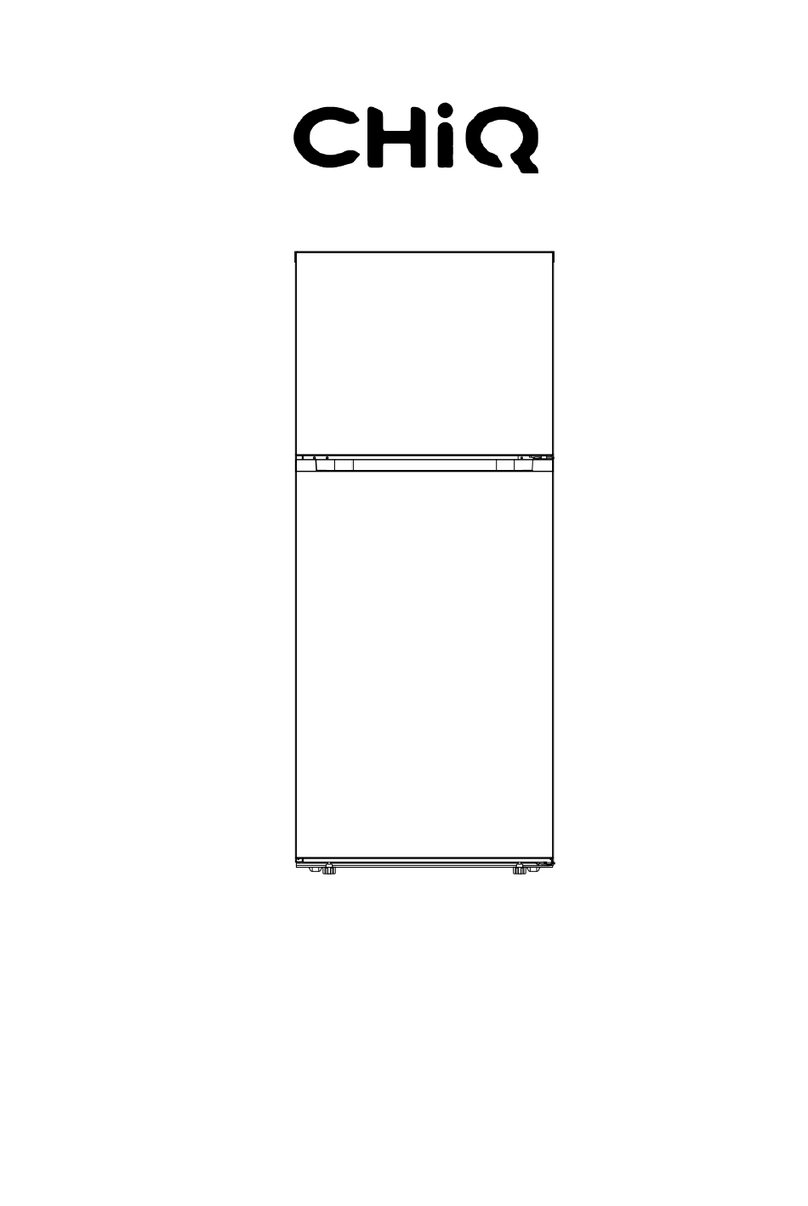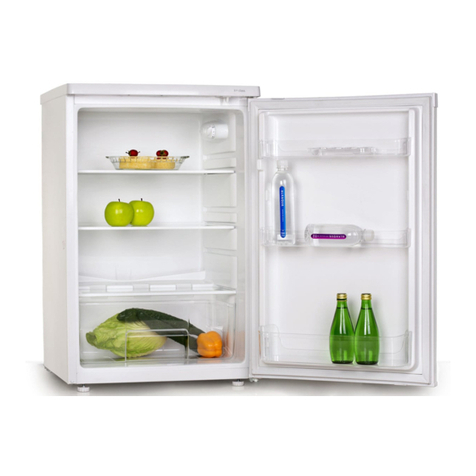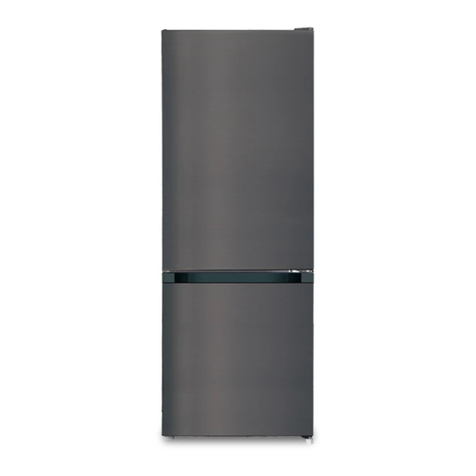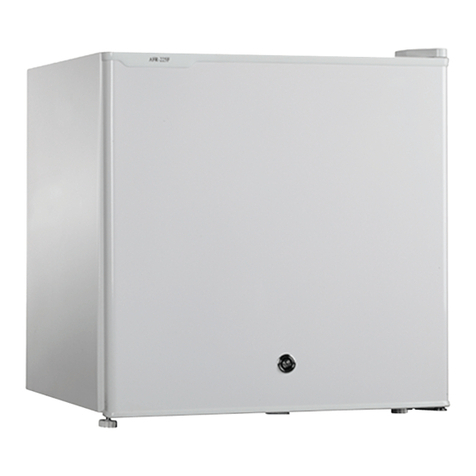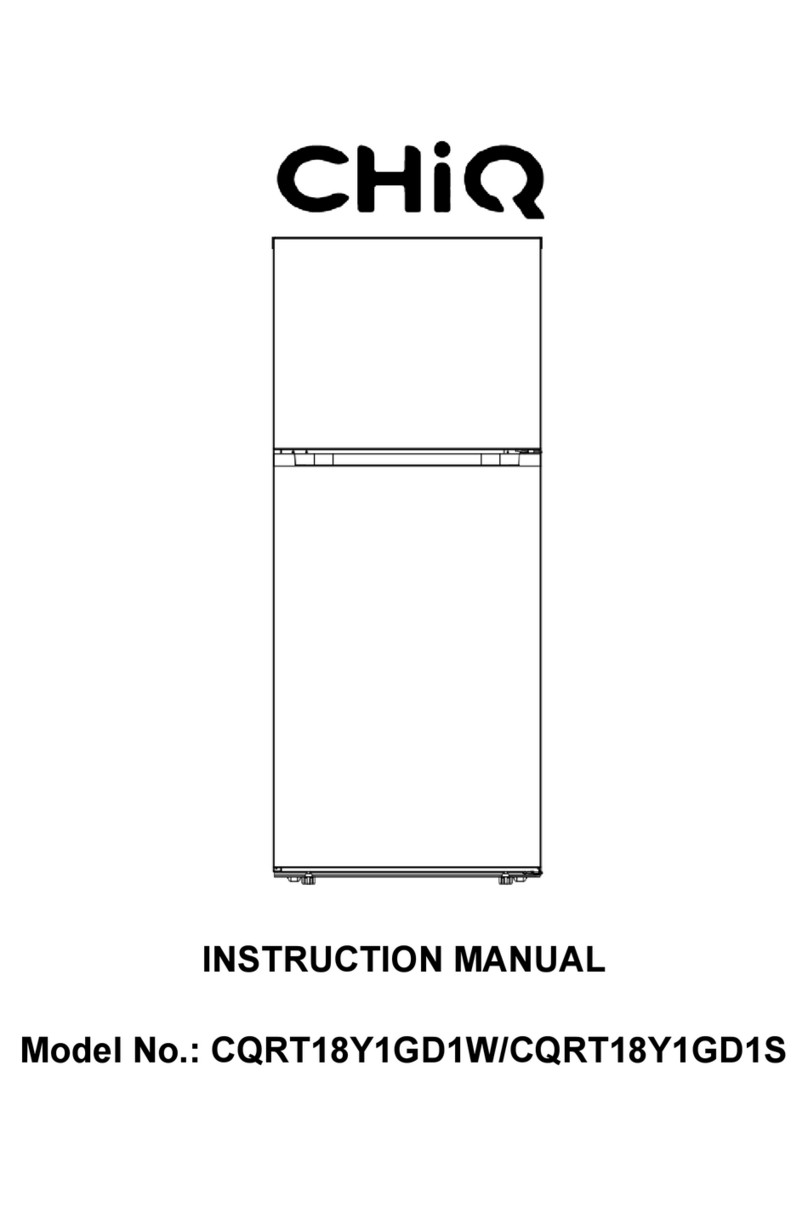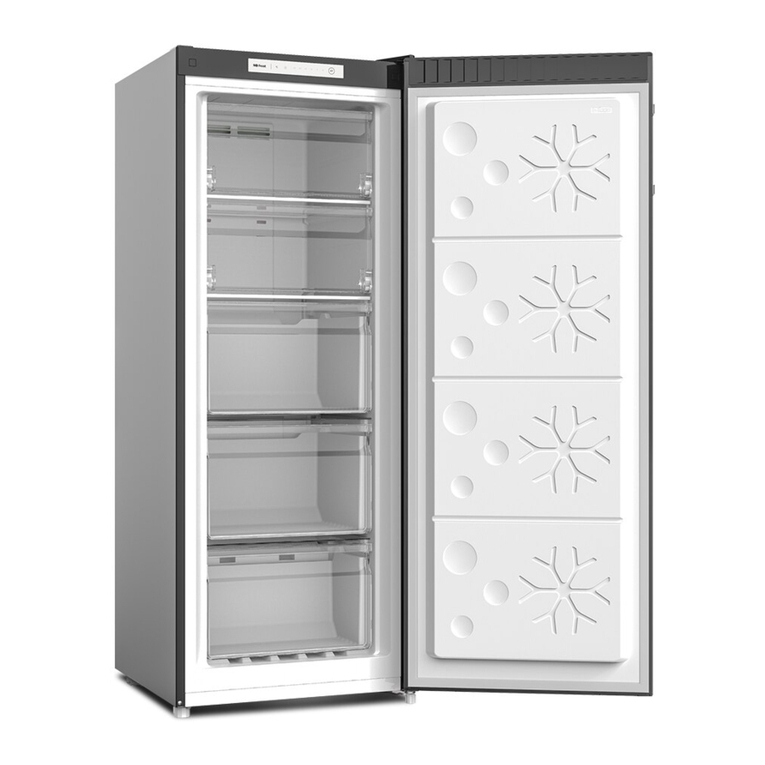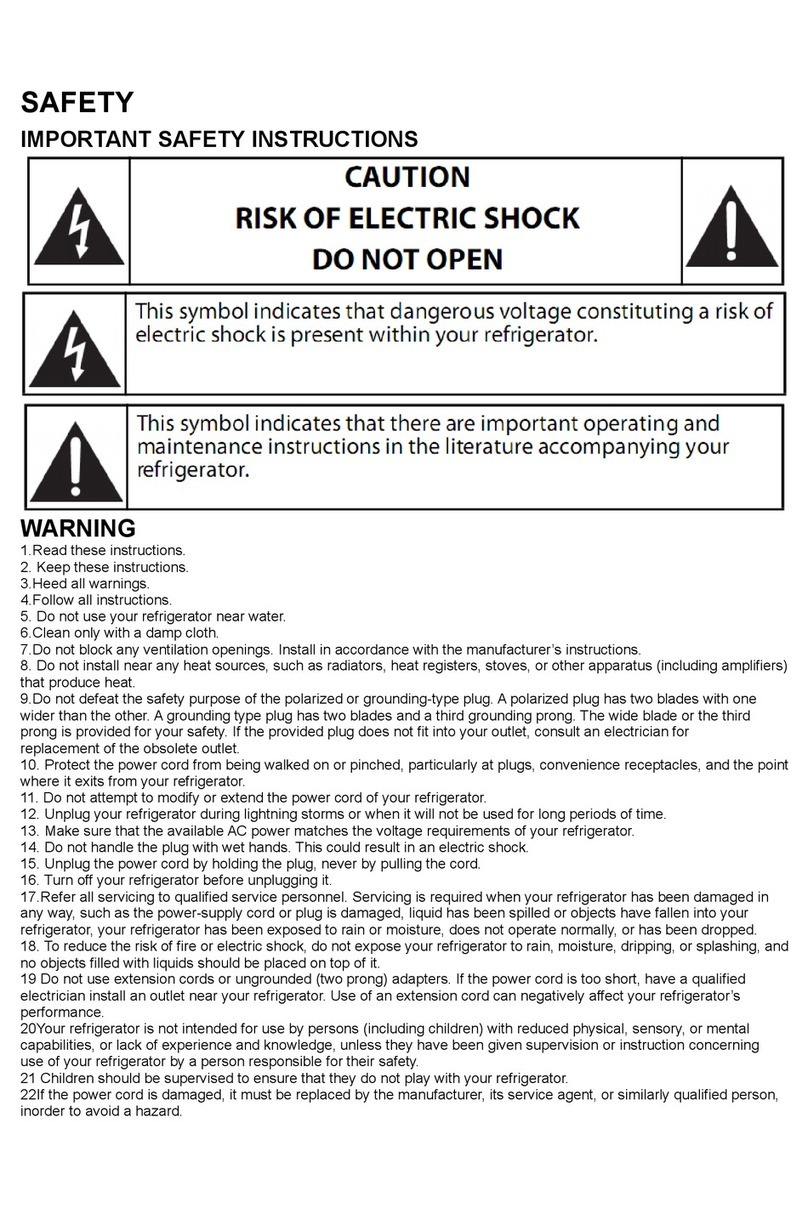ChiQ FBM250NE42 User manual


EN
Contents
I. SAFETY(general safety warnings).......................................................................................................... 3
II. Product Features............................................................................................................................................. 5
III. Preparations for use....................................................................................................................................... 6
IV. Functions......................................................................................................................................................... 7
V. Instructions for food storage.......................................................................................................................... 8
VI. Tips for special needs.................................................................................................................................... 9
VII. Maintenance and cleaning........................................................................................................................... 9
VIII. Simple fault analysis and elimination (varying with different products) ..................................................... 12
IX. Certifications (to be provided by Certification Engineer) .................................................................................. 12
X. Safe recovery instructions........................................................................................................................... 13
Dear users, this manual contains the product’s basic knowledge,
how to use it, fault diagnosis and basic troubleshooting methods.
In order to better understand and use this product, please take
good care of this manual and read it carefully.

EN
I. SAFETY(general safety warnings)
WARNING!
It is hazardous for anyone other than authorized service personnel to carry out servicing or repairs which involves the
removal of covers. To avoid the risk of an electric shock do not attempt to repair this appliance yourself.
WARNING!
Risk of fire / flammable materials.
Safety tips
Do not use electrical appliances such as a hair dryer or heater to defrost your Freezer.
Containers with flammable gases or liquids can leak at low temperatures.
Do not store any containers with flammable materials, such as spray cans, fire extinguisher refill cartridges etc. in the
Freezer.
Do not place carbonated or fizzy drinks in the Freezer compartment. Ice lollies can cause “Frost/Freeze burns”if
consumed straight from the Freezer.
Do not remove items from the Freezer compartment if your hands are damp/wet, as this could cause skin abrasions or
“Frost/Freezer burns”. Bottles and cans must not be placed in the Freezer compartment as they can burst when the
contents freeze.
Manufacturer’s recommended storage times should be adhered to. Refer to relevant instructions.
Do not allow children to tamper with the controls or play with the Freezer. The Freezer is heavy. Care should be taken
when moving it. It is dangerous to alter the specification or attempt to modify this product in any way.
Do not store inflammable gases or liquids inside your Freezer.
If the power cable is damaged, it must be replaced by the manufacturer, its service agent or similarly qualified persons in
order to avoid a hazard.
This appliance can be used by children aged from 8 years and above and persons with reduced physical, sensory or
mental capabilities or lack of experience and knowledge if they have been given supervision or instruction concerning use
of the appliance in a safe way and understand the hazards involved. Children shall not play with the appliance. Cleaning
and user maintenance shall not be made by children without supervision.
This appliance is intended to be used in household and similar applications such as
·staff kitchen areas in shops, offices and other working environments;
·farm houses and by clients in hotels, motels and other residential type environments;
·bed and breakfast type environments;
·catering and similar non-retail applications.
Keep ventilation openings in the appliance enclosure or in the built-in structure clear of obstruction.
Do not use mechanical devices or other means to accelerate the defrosting process, other than those recommended by
the manufacturer.

EN
Do not damage the refrigerant circuit.
Do not store explosive substances such as aerosol cans with a flammable propellant in this appliance.
–WARNING: Do not use electrical appliances inside the food storage compartments of the appliance, unless they are of
the type recommended by the manufacturer.
–WARNING: Refrigerating appliances –in particular a refrigerator-freezer Type I –might not operate consistently (there is
possibility of defrosting of contents or temperature becoming too warm in the frozen food compartment) when sited for an
extended period of time below the cold limit of the temperature range for which the refrigerating appliance is designed;
–WARNING: It is necessary that, for doors or lids fitted with locks and keys, the keys be kept out of the reach of children
and not in the vicinity of the refrigerating appliance, in order to prevent children from being locked inside.
–WARNING: The refrigerant used in your appliance and insulation materials needs special disposal procedures.
–WARNING: When positioning the appliance, ensure the supply cord is not trapped or damaged.
–WARNING: Do not locate multiple portable socket-outlets or portable power supplies at the rear of the appliance
Electrical Connection
WARNING
This appliance should be properly grounded for your safety. The power cord of this appliance is equipped with a
three-prong plug which mates with the standard three prong wall outlets to minimize the possibility of electrical
shock.
Do not, under any circumstances, cut or remove the third ground prong from the power cord supplied.
This refrigerator appliance requires a standard 220-240VAC ∽/50Hz electrical outlet with three-prong ground.
This refrigerator appliance is not designed to be used with an inverter.
The cord should be secured behind the appliance and not left exposed or dangling to prevent accidental injury.
Never unplug the refrigerator by pulling the power cord. Always grip the plug firmly and pull straight out from the
receptacle.
Do not use an extension cord with this appliance. If the power cord is too short, have a qualified electrician or service
technician install an outlet near the appliance. Use of an extension cord can negatively affect the performance of the
unit.
Improper use of the grounded plug can result in the risk of electrical shock. If the power cord is damaged, have it
replaced by an authorized service center.
Climate Range
The information about the climate range of the appliance is provided on the rating plate. It indicates at which ambient
temperature (that is, room temperature, in which the appliance is working) the operation of the appliance is optimal
(proper).
Climate range
Permissible ambient temperature
SN
from +10°C to +32°C
N
from +16°C to +32°C
ST
from +16°C to +38°C
T
from +16°C to +43°C
Note:Given the limit values of the ambient temperature range for the climate classes for which the refrigerating
appliance is designed and the fact that the internal temperatures could be affected by such factors as location of the
refrigerating appliance, ambient temperature and the frequency of door opening, the setting of any temperature control
device might have to be varied to allow for these factors, if appropriate.
Locks
If your Refrigerator is fitted with a lock, keep the key out of reach and not in the vicinity of the appliance to prevent children
being entrapped. When disposing of an old Refrigerator, break off any old locks or latches as a safeguard.
Freon-free
The freon-free refrigerant (R600a) and the foaming insulation material (cyclopentane) that is environmentally friendly are
used for the refrigerator, causing no damage to the ozone layer and having a very small impact on the global warming.
R600a is flammable, and sealed in a refrigeration system, without leakage during normal use. But, in case of refrigerant
leakage due to the refrigerant circuit being damaged, be sure to keep the appliance away from open flames and open the
windows for ventilation as quickly as possible.

EN
II. Product Features
Total no frost design
Multi air-flow cooling system
Electronic temperature control
Interior LED lighti
Parts name:
No
Description
1
Operation panel
2
Fridge glass shelf
3
Crisper cover
4
Crisper
5
Freezer drawer
6
Leveling foot
7
Bottle rack

IT
Due to technological innovations, the product descriptions in this manual may not be completely consistent with
your refrigerator. Detailed information is in accordance with the final product.
III. Preparations for use
Installation location:
1. Ventilation condition
The position you select for the refrigerator installation should be well-ventilated and has less hot air. Do not locate the
refrigerator near a heat source such as cooker, and avoid it from direct sunlight, thus guaranteeing the refrigeration effect
while saving energy consumption. Do not locate the refrigerator in the damp place, so as to prevent the refrigerator from
rusting and leaking electricity. The result of the total space of the room in which the refrigerator is installed being divided
by the refrigerant charge amount of the refrigerator shall not be less than 8 g/ M3.
Note: The amount of refrigerant charged for the refrigerator can be found on the nameplate.
2. Heat dissipation space
When working, the refrigerator gives off heat to surroundings. Therefore, at least 300mm of free space should be spared
at the top side, more than 100mm on both sides, and above 50mm at the side of the refrigerator.
Dimensions in mm:
W
D
H
A
B
C(°)
E
F
540
576
1800
845
1095
125±5
50
100
Fig. 1 Fig. 2
Note:Figure 1, Figure 2 only illustrate the space demand of the product.
3. Level ground
Place the refrigerator on the solid and flat ground (floor) to keep it stable, or else, it will give rise to vibration and noise.
When the refrigerator is placed on such flooring materials as carpet, straw mat, polyvinyl chloride, the solid backing plates
should be applied underneath the refrigerator, so as to prevent color change due to heat dissipation.
Unobstructed ventilation shall be maintained around the appliance or in an embedded structure.
Preparations for use
1. Standing time
After the refrigerator is properly installed and well cleaned, do not switch it on immediately. Make sure to energize the
refrigerator after more than 1 hour’s standing, so as to ensure its normal operation.
2. Cleaning
Confirm the accessory parts inside the refrigerator and wipe the inside with a soft cloth.
3. Power-on
Insert the plug into the solid socket to start the compressor. After 1 hour, open the refrigerator door, if the temperature
inside the refrigerator compartment drops obviously, it indicates the refrigeration system is working normally.
4. Storage of food
After the refrigerator runs for a period of time, the internal temperature of the refrigerator will be automatically controlled
according to the user’s temperature setting. After the refrigerator is fully cooled, put in foods, which usually need 2~3
hours to be fully cooled. In summer, when the temperature is high, it takes more than 4 hours for the foods to be fully
cooled (Try to open the refrigerator door as less as possible before the internal temperature cools down).

IT
If the refrigerator is installed in the moisture place, make sure to check whether the ground wire and leakage circuit
breaker are normal. If vibration noises are produced due to the refrigerator contacting the wall or if the wall gets blackened
by air convection around the compressor, move the refrigerator away from the wall. Setting up the refrigerator may cause
jamming noise or image chaos to the mobile phone, fixed-line telephone, radio receiver, television surrounding it, so try to
keep the refrigerator as far away as possible in such case.
IV. Functions
When the refrigerator system is powered on for the first time, all icons on the display panel gets illuminated for 2s, and the
system runs at 4℃by default.
1.Functions
1.1 Temperature setting
Temperature can be adjusted by pressing the ‘SET’ key, and if no key operation within 3s after temperature setting, the
said setting will be validated, with the temperature immediately controlled as per the setting; and the mode indicator light
will go off after 3 seconds.
The temperature modes cycle as following: “2→4→5→6→8→FAST COOL→2”
In the spring and autumn seasons when ambient temperatures range between 16-35℃, it is advisable to set the
temperature at Mode 4, 5 or 6, and adjust the air regulating lever to the MID. position.
In summer when ambient temperature is above 35℃, it is general to set the temperature at Mode2, and adjust the air
regulating lever between MID and MIN.
In winter when ambient temperature is at or below 16℃, it is general to set the temperature at Mode 2, and adjust the air
regulating lever between MAX and MID., with MAX. or approaching the Max. being preferable.
1.2 “FAST COOL”
Cooling down the temperature in a rapid manner is beneficial to the prevention of food nutrition against lost and the
preservation of freshness.
After a cumulative running period of 3 hours, the fast cooling function will exit automatically, with the temperature mode
restored to that set before the fast cooling function is enabled.
1.3 Door open alarm
When the fridge door keeps open for more than 10 minutes, the LED lamp begins flashing for alarm purpose, which will
not stop until the said door is closed.
1.4 Power cut memory
In case of power failure, the refrigerator will maintain the operating state before power failure when power supply is
restored.
1.5 Power-on delay
In order to protect the refrigerator compressor from being damaged in the case of short-time power failure (i.e., less
than 5 minutes), the compressor will not be started immediately after it is powered on.

IT
1.6 Fault alarm
When the indicator light of Mode 2 or Mode 5 keeps flashing, it indicates fault with the refrigerator. Please contact the
aftersales person for visiting service in such case.
V. Instructions for food storage
Precautions for use
The appliance might not operate consistently (there is possibility of defrosting or temperature becoming too warm in
the frozen food compartment) when sited for an extended period of time below the cold limit of the temperature range
for which the refrigerating appliance is designed
The information of climate type of the appliance is provided on the rating plate.
The internal temperature could be affected by such factors as the location of refrigerating appliance, ambient
temperature, and frequency of door open, etc., and if appropriate, a warning that setting of any temperature control
device might have to be varied to allow for these factors should be made.
Effervescent drinks should not be stored in the freezer compartment or the low-temperature compartment, and some
products such as water ices should not be consumed too cold.
Food storage location
Due to the cold air circulation in the refrigerator, the temperature of each area in the refrigerator is different, so different
kinds of food should be placed in different areas.
The fresh food compartment is suitable for the storage of such foods as need not to be frozen, the cooked food, beer,
eggs, some condiments that need cold preservation, milk, fruit juice, etc. The crisper box is suitable for the preservation of
vegetables, fruits, etc.
The freezer compartment is suitable for the storage of ice cream, frozen food and the foods to be preserved for a long
time.
Use of the fresh food compartment
Set the temperature of the fresh food storage compartment between 2 ℃~ 8 ℃, and store the foods that are intended
for short-term storage, or to be eaten at any time in the fresh food compartment.
Fridge shelf: When removing the shelf, lift it up first, and then pull it out; and when installing the shelf, place it into position
before putting it down. Keep the shelf rear flange upward, to prevent foods from contact the liner wall. When taking out or
putting in the shelf, hold it firmly, and handle with care to avoid damage.
Crisper box: Pull out the crisper box for access to food. After using or cleaning the cover plate of the crisper box, be sure
to put it back onto the crisper, so that the internal temperature of the crisper box will not be affected.
Use of the crisper humidity regulating rod
The humidity regulating rod of the crisper box is design to maintain the humidity and freshness of the vegetables stored
inside.
When the humidity regulating rod is slide to the right, with more holes exposed, lower humidity will be kept inside the
crisper box.
When the humidity regulating rod is slide to the left, with less holes exposed, higher humidity will be kept inside the crisper
box.
Cautions for food storage
You’d better clean the foods and wipe them dry before storing them inside the refrigerator. Before foods are put in the
refrigerator, it is advisable to seal them up, so as to prevent water evaporation to keep fresh fruits and vegetables on one
hand, and prevent taint of odor on the other hand.
Do not put too many or too heavy foods inside the refrigerator. Keep enough space between foods; if too close, the cold
air flow will be blocked, thus affecting the refrigeration effect. Do not store excessive or overweight foods, to avoid the
shelf from being crushed. When storing the foods, keep a distance away from the inner wall; and do not place the
water-rich foods too close to the fridge rear wall, lest they get frozen on the inner wall.
Categorized storage of foods:Foods should be stored by category, with the foods you eat every day placed in front of the
shelf, so that the door open duration can be shortened and food spoilage due to expiration can be avoided.
Energy-saving tips: Allow the hot food cool down to the room temperature before putting it in the refrigerator. Put the
frozen food in the fresh food compartment to thaw, using the low temperature of the frozen food to cool the fresh food,
thus saving energy.
Storage of fruits and vegetables
In the case of refrigerating appliances with chill compartment, a statement to the effect that some types of fresh
vegetables and fruits are sensitive to cold and therefore are not suitable for storage in this kind of compartment should be
made.
Use of the frozen food storage compartment

IT
The freezer temperature is controlled below -18 ℃, and it is advisable to store the food for long-term preservation in the
freezer compartment, but the storage duration indicated on the food packaging should be adhered to.
The freezer drawers are used to store food that needs to be frozen. Fish and meat of large block size should be cut into
small pieces and packed into fresh-keeping bags before they are evenly distributed inside the freezer drawers.
★Allow the hot foods to cool down to the room temperature before putting them in the freezer compartment.
★Do not put a glass container with liquid or the canned liquid that is sealed in the freezer compartment, so as to avoid
burst due to volume expansion after the liquid gets frozen up.
★Divide the food into appropriately small portions
★You’d better pack the food up before freezing it, and the packing bag used should be dry, in case the packing bags are
frozen together. Foods should be packed or covered by such suitable materials as are firm, tasteless, impervious to air
and water, non-toxic and pollution-free, to avoid cross-contamination and transfer of odor.
Tips for shopping the frozen foods
1.When you are buying frozen food, look at the Storage Guidelines on the packaging. You will be able to store each item
of frozen food for the period shown against the star rating. This is usually the period stated as “Best to use them before×”,
found on the front of the packaging.
2.Check the temperature of the frozen food cabinet in the shop where you buy the frozen foods.
3.Make sure the frozen food package is in perfect condition.
4.Always buy frozen products last on your shopping trip or visit to the supermarket.
5.Try to keep frozen food together whilst shopping and on the journey home, as this will help to keep the food cooler.
6.Don’t buy frozen food unless you can freeze it straight away. Special insulated bags can be bought from most
supermarkets and hardware shops. These keep the frozen foods cold longer.
7.For some foods, thawing before cooking is unnecessary. Vegetables and pasta can be added directly to boiling water or
steam cooked. Frozen sauces and soups can be put into a saucepan and heated gently until thawed.
8.Use quality food and handle it as little as possible. When foods are frozen in small quantities, it will take less than for
them to freeze up and thaw.
9.Estimate the amount of foods to be frozen up. When freezing large amounts of fresh food, adjust the temperature
control knob to the low mode, with the freezer temperature lowered. So, foods can be frozen up in fast manner, with the
food freshness well kept.
VI. Tips for special needs
Moving the refrigerator/freezer
•Location
Do not place your refrigerator/freezer near a heat source, e.g. cooker, boiler or radiator. Avoid it from direct sunlight in
out-buildings or sun lounges.
•Leveling
Make sure to level your refrigerator/freezer using the front leveling feet. If not level, the refrigerator/freezer door gasket
sealing performance will be affected, or even it may lead to the operating failure of your refrigerator/freezer.
After locating the refrigerator/freezer in position, wait for 4 hours before using it, so as to allow the refrigerant to settle.
•Installation
Do not cover or block the vents or grilles of your appliance.
When you are out for a long time
•If the appliance will not be used for several months, turn it off first, and then unplug the plug from the wall outlet.
•Take out all foods.
•Clean and dry the interior thoroughly. To prevent odor and mold growth, leave the door ajar: block it open or have the
door removed if necessary.
•Keep the cleaned appliance in a dry, ventilated place and away from the heat source, place the appliance smoothly,
and do not place heavy objects on top of it.
•The unit should not be accessible to child’s play.
VII. Maintenance and cleaning
Before cleaning, unplug the power plug first; Do not plug in or plug out the plug with wet hand, because
there is a risk of electric shock and injury. Do not spill water directly on the refrigerator, to avoid rust, electricity
leakage and accidents. Do not stretch your hands into the bottom of the refrigerator, since you might be
scratched by sharp metal corners.
Internal cleaning and external cleaning
The food residuals in the refrigerator are liable to produce bad odor, so the refrigerator must be cleaned regularly. The

IT
fresh food compartment is usually cleaned once a month.
Remove all shelves, crisper box, bottle racks, cover board, and drawers etc., and clean them with a soft towel or sponge
dipped in warm water or neutral detergent.
Clear off the dusts accumulated on the rear panel and side plates of the refrigerator often.
After using detergent, be sure to rinse it with clean water, and then wipe it dry.
Do not use bristle brush, steel wire brush, detergent, soap powder, alkaline detergent, benzene, gasoline,
acid, hot water and other corrosive or soluble items to cleanse the cabinet surface, door gasket, plastic
decorative parts, etc., so as to avoid damage.
Carefully wipe dry the door gasket, clean the groove using a wooden chopstick wrapped with cotton string. After the
cleaning, fix the four corners of the door gasket first, and then embed it segment by segment into the door groove.
Interruption of power supply or failure of the refrigerating system
•Take care of the frozen foods in the event of an extended non-running of the refrigerating appliance (such as interruption
of power supply or failure of the refrigerating system).
•Try to open the refrigerator door as less as possible, in this way can food safely and freshly kept for hours even in hot
summer.
•If you get the power outage notice in advance:
1) Adjust the thermostat knob to the high mode an hour in advance, so that foods get fully frozen (Do not
store new food during this time!). Restore the temperature mode to the original setting when power supply becomes
normal in a timely manner.
2) You can also make ice with a watertight container, and put it in the upper part of the freezer, so as to
extend the time for fresh food to be stored.
Note: Once the refrigerator is used, you’d better use it continuously; and under normal circumstance, do not
stop its use, so as not to affect the service life.
Defrosting
This appliance is designed with automatic defrosting function, thus no need to defrost it manually.
Changing the lamp
The LED lamp is used by the refrigerator for lighting, which features low energy consumption and long service life. In case
of any abnormality, please contact the after-sales personnel for visiting service.
Safety-check after maintenance
Is the power cord broken or damaged?
Is the power plug firmly inserted into the socket?
Is the power plug abnormally overheat?
Note: Electric shock and fire accident may be caused in case the power cord and plugs are damaged or
stained by dust. If any abnormality, please unplug the power plug and get in contact with the vendor.
How to dissemble the parts
Fridge door bottle rack:
Hold the bottle rack with both hands, and then push it up.
Fridge shelf:
Hold one end of the shelf to lift it up, and meantime pull it outward, in this way can the shelf be taken
out.

IT

IT
VIII. Simple fault analysis and elimination (varying with different products)
With regard to the following small faults, not every failure needs to be fixed by the technical service personnel; you can try
to solve the problem.
Case
Inspection
Solutions
●Completely
non-refrigeration
Is power plug off?
Are breakers and fuses a broken?
No electricity or line trip?
Re-plug.
Opening the door and checking whether the
lamp is lit.
•Abnormal noise
Is refrigerator stable?
Does refrigerator reach the wall?
Adjusting refrigerator's adjustable feet.
Off the wall.。
•Poor
refrigerating
efficiency
Do you put hot food or too much food?
Do you open the door frequently?
Do you clip food bag to the seal of door?
Direct sunlight or near a furnace or stove?
Is it well-ventilated?
Temperature setting in too high?
Putting food into refrigerator when hot food
becomes cool.
Checking and closing the door.
Removing the refrigerator from the heat
source.
Emptying the distance to maintain good
ventilation.
Setting to the appropriate temperature.
•Peculiar smell in
refrigerator
Any spoiled food?
Do you need to clean refrigerator?
Do you pack food of strong flavors?
Throwing away spoiled food.
Cleaning refrigerator.
Packing food of strong flavors.
I.LED lamp always
flashing
II. Is the door open for more than 10
minutes?
III.Close the fridge door, open it again in 2s, checking
whether the LED lamp restores to normal.
Note: If the above descriptions are inapplicable to troubleshooting, do not disassemble and repair it yourself. Repairs
carried out by inexperienced persons may cause injury or serious malfunctioning. Contact the local store where your
purchase was made. This product should be serviced by an authorized engineer and only genuine spare parts should be
used.
When the appliance is not in use for long periods, disconnect from the electricity supply, empty all foods and clean the
appliance, leaving the door ajar to prevent unpleasant smells.
IX. Certifications (to be provided by Certification Engineer)
Electrical information
This electrical appliance must be grounded.
This product is equipped with a plug, which is suitable for all houses equipped with sockets meeting the current
specifications
If the fitted plug is not suitable for your socket outlets, it should be cut off and carefully disposed of. To avoid a possible
shock hazard, do not insert the discarded plug into a socket.
This product complies the EEC directives.

IT
X. Safe recovery instructions
Disposal
Old appliances still have some surplus value. An environmentally friendly approach will ensure that valuable raw materials
are recycled.
The refrigerants used in your equipment and insulation materials require special handling procedures. Make sure there is
no pipe damage on the back of the equipment before handling.
Up-to-date information on the options for disposing of old equipment and packaging from old equipment can be obtained
from the local municipal office.
Correct Disposal of this product
This marking indicates that this product should not be disposed with other household wastes
throughout the EU. To prevent possible harm to the environment or human health from uncontrolled
waste disposal, recycle it responsibly to promote the sustainable reuse of material resources. To
return your used device, please use the return and collection systems or contact the retailer where
the product was purchased. They can take this product for environmentally safe recycling.

IT
Indice
I. SICUREZZA(Avvertenze generali sulla sicurezza)............................................................................................. 3
II. Caratteristiche del prodotto .............................................................................................................................. 5
III. Preparazione all’uso.......................................................................................................................................... 5
IV. Funzioni............................................................................................................................................................. 7
V. Istruzioni per la conservazione degli alimenti ................................................................................................... 7
VI. Suggerimenti per esigenze speciali ................................................................................................................... 9
VII. Manutenzione e pulizia ....................................................................................................................................... 9
VIII. Semplice analisi ed eliminazione dei guasti (varia in base al prodotto) ................................................................. 11
IX. Certificazioni (fornite dall’ingegnere di certificazione)................................................................................................ 12
X. Istruzioni per il recupero sicuro ....................................................................................................................... 12

IT
IV. SICUREZZA
AVVERTENZA!
Eseguire interventi di assistenza o riparazione che implichino la rimozione delle coperture è rischioso per chiunque e, pertanto,
responsabilità esclusiva dei tecnici autorizzati. Per evitare il rischio di scossa elettrica, non tentare di riparare l’apparecchio
autonomamente.
AVVERTENZA!
Rischio di incendio / materiali infiammabili.
Suggerimenti per la sicurezza
Non utilizzare apparecchi elettrici come asciugacapelli o termosifoni per sbrinare il congelatore.
Icontenitori con gas o liquidi infiammabili possono evidenziare la presenza di fuoriuscite a basse temperature.
Non conservare contenitori con materiali infiammabili quali bombolette spray, ricariche per estintori e cosìvia nel congelatore.
Non inserire bibite gassate o effervescenti nel vano congelatore. I ghiaccioli possono causare "bruciature/ustioni da gelo" se
consumati direttamente dopo essere stati prelevati dal congelatore.
Non rimuovere gli oggetti dal vano congelatore se le mani sono umide/bagnate, in quanto ciò potrebbe causare abrasioni cutanee
o "bruciature/ustioni da gelo". Le bottiglie e le lattine non devono essere collocate nel vano congelatore, poiché possono scoppiare
quando il contenuto si congela.
Ènecessario rispettare i tempi di conservazione consigliati dal produttore. Fare riferimento alle istruzioni pertinenti.
Non consentire ai bambini di manomettere i comandi o giocare con il congelatore. Il congelatore è pesante. Prestare attenzione
durante lo spostamento. Alterare le specifiche o tentare di modificare il prodotto in qualsivoglia modo costituisce un pericolo.
Non conservare gas o liquidi infiammabili all'interno del congelatore.
Se danneggiato, il cavo di alimentazione deve essere sostituito dal produttore, dal suo addetto all'assistenza o da personale
parimenti qualificato al fine di evitare pericoli.
Questo apparecchio può essere usato da bambini al di sopra degli 8 anni e da persone con ridotte capacità fisiche, psichiche o
sensoriali, oppure senza esperienza e conoscenza del prodotto, solo sotto supervisione o a seguito di istruzioni per un uso sicuro del
prodotto e conseguente comprensione dei rischi connessi all’utilizzo dello stesso. I bambini non devono giocare con questo
apparecchio. La pulizia e la manutenzione non devono essere eseguite da bambini senza supervisione.
Questo apparecchio è destinato all’utilizzo in ambienti domestici o simili, come
•aree cucina per lo staff in negozi, uffici e altri ambienti di lavoro;
•agriturismi e da parte dei clienti di hotel, motel e altri ambienti residenziali;
•ambienti quali bed and breakfast;
•catering e attività simili che non comportino la vendita al dettaglio.
Mantenere le aperture di ventilazione, nell'alloggiamento dell'apparecchio o nella relativa struttura integrata, libere da ostruzioni.
Non utilizzare dispositivi meccanici o altri strumenti non raccomandati dal produttore per accelerare il processo di sbrinamento.

IT
Non danneggiare il circuito di refrigerazione.
Non utilizzare apparecchi elettrici non raccomandati dal produttore all'interno dei vani per la conservazione di alimenti.
Non conservare oggetti esplosivi, come bombolette spray contenenti propellente infiammabile, all'interno dell'apparecchio.
Questo apparecchio può essere usato da persone (bambini inclusi) con ridotte capacità fisiche, psichiche o sensoriali, oppure
senza esperienza e conoscenza del prodotto, solo sotto supervisione o a seguito di istruzioni per un uso sicuro del prodotto e
conseguente comprensione dei rischi connessi all’utilizzo dello stesso. I bambini devono essere sorvegliati per assicurarsi che non
giochino con l'apparecchio.
–AVVERTENZA: mantenere le aperture di ventilazione, nell'alloggiamento dell'apparecchio o nella relativa struttura integrata, libere
da ostruzioni.
–AVVERTENZA: non utilizzare dispositivi meccanici o altri strumenti non raccomandati dal produttore per accelerare il processo di
sbrinamento.
–AVVERTENZA: non danneggiare il circuito di refrigerazione.
–AVVERTENZA: non utilizzare apparecchi elettrici non raccomandati dal produttore all'interno dei vani per la conservazione di
alimenti.
–AVVERTENZA: gli apparecchi di refrigerazione, in particolare un frigorifero-congelatore di tipo I, potrebbero non funzionare in
modo coerente (esiste la possibilità di sbrinamento o che la temperatura diventi troppo alta nel vano congelatore) se collocati per
un lungo periodo di tempo al di sotto del limite freddo dell'intervallo di temperatura per il quale sono stati progettati;
–AVVERTENZA: con riferimento a sportelli o coperchi muniti di serrature e chiavi, è necessario che le chiavi siano tenute fuori dalla
portata dei bambini e non nelle vicinanze dell'apparecchio di refrigerazione, al fine di evitare che i bambini vengano chiusi
all'interno.
–AVVERTENZA: il refrigerante utilizzato nell'apparecchio e i materiali isolanti necessitano di procedure di smaltimento speciali.
–AVVERTENZA: in fase di posizionamento dell'apparecchio, assicurarsi che il cavo di alimentazione non sia intrappolato o
danneggiato.
–AVVERTENZA: non collocare prese multiple portatili o alimentatori portatili sul retro dell'apparecchio
I bambini di età compresa fra 3 e 8 anni sono autorizzati a caricare e scaricare gli apparecchi di refrigerazione.
Per evitare la contaminazione del cibo, si prega di rispettare le seguenti istruzioni:
–L'apertura dello sportello per lunghi periodi può causare un significativo aumento della temperatura
nei vani dell’apparecchio.
–Pulire regolarmente le superfici che possono venire a contatto con il cibo e i sistemi di drenaggio accessibili.
–Pulire i serbatoi dell'acqua se non sono stati utilizzati per 48 ore; lavare l'impianto idrico collegato a una rete idrica se l'acqua non
è stata aspirata per 5 giorni.
–Conservare la carne e il pesce crudi in contenitori idonei all’interno del frigorifero, in modo che non entrino in contatto con, o
sgocciolino su, altro cibo.
–I vani del congelatore a due stelle sono adatti per conservare cibi pre-congelati, conservare o preparare
gelati e preparare cubetti di ghiaccio.
–I vani a una, due e tre stelle non sono adatti al congelamento di cibo fresco.
–Se l'apparecchio di refrigerazione viene lasciato vuoto per lunghi periodi, spegnere, sbrinare, pulire, asciugare e lasciare lo
sportello aperto per evitare lo sviluppo di muffa al suo interno.
Collegamento elettrico
L’apparecchio deve essere dotato di opportuna messa a terra per motivi di sicurezza. Il cavo di alimentazione di questo
apparecchio è dotato di una spina a tre poli che può essere inserita nelle prese a muro a tre poli standard per ridurre al minimo la
possibilità di scossa elettrica.
Non tagliare né rimuovere in alcun caso il terzo polo di messa a terra dal cavo di alimentazione fornito.
Questo frigorifero richiede una presa elettrica standard da 220-240 V CA ~/50 Hz con messa a terra a tre poli.
Questo frigorifero non è progettato per essere utilizzato con un inverter.
Il cavo deve essere fissato dietro l'apparecchio e non lasciato esposto o sospeso per evitare lesioni accidentali.
Non scollegare mai il frigorifero tirando il cavo di alimentazione. Afferrare sempre saldamente la spina ed estrarla dalla presa.
Non utilizzare una prolunga con questo apparecchio. Se il cavo di alimentazione è troppo corto, far installare una presa vicino
all'apparecchio da un elettricista qualificato o da un tecnico dell'assistenza. L'uso di una prolunga può compromettere le prestazioni
dell'unità.
L'uso improprio della spina con messa a terra può comportare il rischio di scosse elettriche. Se il cavo di alimentazione è
danneggiato, farlo sostituire da un centro di assistenza autorizzato.
Classe climatica
Le informazioni sulla classe climatica dell'apparecchio sono riportate sulla targhetta dei dati. Indica a quale temperatura ambiente
(ovvero temperatura dell’ambiente in cui è utilizzato l'apparecchio) il funzionamento dell'apparecchio è ottimale (corretto).

IT
Classe climatica
Temperatura ambiente consentita
SN
da +10°C a +32 °C
N
da +16 °C a +32 °C
ST
da +16 °C a +38 °C
T
da +16 °C a +43 °C
Nota: dati i valori limite dell'intervallo di temperatura ambiente per le classi climatiche per cui è progettato il frigorifero e
considerato il fatto che le temperature interne potrebbero essere influenzate da fattori come la posizione dell'apparecchio stesso,
la temperatura ambiente e la frequenza di apertura dello sportello, potrebbe essere appropriato modificare l'impostazione di
qualsiasi dispositivo di controllo della temperatura per tenere conto di questi fattori.
Serrature
Se il frigorifero è dotato di una serratura, tenere la chiave fuori dalla portata e non nelle vicinanze dell'apparecchio per evitare che i
bambini possano rimanere intrappolati. In fase di smaltimento di un frigorifero usato, rompere le vecchie serrature o i catenacci
come misura di sicurezza.
Senza freon
Il frigorifero utilizza refrigerante senza freon (R600a) e materiale isolante schiumogeno (ciclopentano) rispettosi dell’ambiente, non
causando danni allo strato di ozono e con un impatto minimo sul riscaldamento globale. R600a è infiammabile e sigillato in un
sistema di refrigerazione, senza perdite durante il normale utilizzo. Tuttavia, in caso di perdite di refrigerante dovute al
danneggiamento del circuito frigorifero, assicurarsi di tenere l'apparecchio lontano da fiamme libere e di aprire le finestre per
favorire una tempestiva ventilazione.
I. Caratteristiche del prodotto
Total no frost
Sistema di raffreddamento a flusso d'aria multiplo
Controllo elettronico della temperatura
Illuminazione LED inte
Nome delle parti:
N.
Descrizione
1
Pannello di controllo
2
Ripiano frigo in vetro
3
Coperchio del cassetto per frutta
e verdura
4
Cassetto per frutta e verdura
5
Cassetto del congelatore
6
Piedino livellante
7
Ripiano bottiglie

IT
A causa dell'innovazione tecnologica, le descrizioni del prodotto in questo manuale potrebbero differire dal frigorifero in
uso. Informazioni dettagliate conformi al prodotto finale.
II. Preparazione all’uso
Posizione di installazione:
1. Condizione di ventilazione
La posizione scelta per l'installazione del frigorifero deve essere ben ventilata e avere meno aria calda. Non collocare il frigorifero
vicino a fonti di calore come fornelli ed evitare la luce diretta del sole, per garantire cosìl'effetto refrigerante e risparmiare energia.
Non collocare il frigorifero in un luogo umido, per evitare ossidazione e perdite di elettricità. Il risultato dello spazio totale della
stanza in cui è installato il frigorifero diviso per la quantità di carica del refrigerante del frigorifero non deve essere inferiore a
8 g/M3.
Nota: la quantità di refrigerante caricata per il frigorifero si trova sulla targhetta.
2. Spazio di dissipazione del calore
Durante il funzionamento, il frigorifero emette calore nell’area circostante. Pertanto, è necessario prevedere almeno 300 mm di
spazio libero sul lato superiore, più di 100 mm su entrambi i lati e oltre 50 mm sul lato posteriore del frigorifero.
Dimensioni in mm:
W
D
H
A
B
C(°)
E
F
540
576
1800
845
1095
125±5
50
100
Nota: le Figure 1 e 2 illustrano esclusivamente la domanda di spazio del prodotto.
3. Livellamento
Posizionare il frigorifero su un terreno solido e piano (pavimento) per mantenerlo stabile, al fine di evitare vibrazioni e rumore.
Quando il frigorifero è collocato su materiali di pavimentazione quali moquette, tappetini di paglia, polivinilcloruro, è necessario
applicare piastre di supporto solide sotto il frigorifero stesso, in modo da evitare un cambiamento di colore dovuto alla dissipazione
del calore.
Non devono essere presenti ostruzioni alla ventilazione intorno all’apparecchio o in una struttura a esso integrata.
Preparazione all’uso
1. Tempo di attesa
Non accendere il frigorifero immediatamente dopo aver eseguito l’installazione e una corretta pulizia. Accendere il frigorifero dopo
oltre 1 ora di attesa, in modo da assicurarne il normale funzionamento.
2. Pulizia
Verificare la presenza delle parti accessorie all’interno del frigorifero e pulirne l’interno con un panno morbido.
3. Accensione
Inserire la spina nella presa per avviare il compressore. Dopo 1 ora, aprire lo sportello del frigorifero: se la temperatura all'interno
del vano frigorifero scende percettibilmente, il sistema di refrigerazione funziona normalmente.
4. Conservazione degli alimenti
Dopo un periodo di accensione, la temperatura interna del frigorifero è controllata automaticamente in base all’impostazione
configurata dall’utente. Una volta che il frigo si è completamente raffreddato, inserire gli alimenti al suo interno, notando che il loro
raffreddamento completo richiede di norma 2~3 ore. In estate, quando la temperatura è elevata, occorrono più di 4 ore affinché gli
alimenti siano completamente raffreddati (prima del raffreddamento della temperatura interna, provare ad aprire lo sportello del
frigorifero il meno possibile).
Se il frigorifero è installato in un luogo umido, assicurarsi di controllare che il filo di terra e l'interruttore differenziale non
presentino anomalie. Se si producono rumori di vibrazione a causa del contatto del frigorifero con la parete o se la parete si

IT
annerisce per convezione d'aria attorno al compressore, allontanare il frigorifero dalla parete. L'installazione del frigorifero
potrebbe causare interferenze su telefono cellulare, telefono fisso, radioricevitore e televisore circostanti, pertanto, in tal caso,
allontanare il più possibile il frigorifero.
III. Funzioni
Alla prima accensione del frigorifero, tutte le icone sul pannello del display si accendono per 2 secondi, e il sistema funziona per
impostazione predefinita a 4 ℃.
1. Funzioni
1.1 Impostazione della temperatura
La temperatura può essere regolata premendo il tasto ‘SET’ e, se non è azionato alcun tasto entro 3 secondi dall’impostazione della
temperatura, suddetta impostazione sarà convalidata e la temperatura sarà immediatamente controllata in base a essa; la spia
dell’indicatore della modalità si spegnerà dopo 3
secondi.
Fast Cook
Fast Cool
Le modalità temperatura sono definite secondo la seguente sequenza: “2→4→5→6→8→FAST COOL→2”
In primavera e autunno, quando la temperatura ambiente varia fra 16 e 35 °C, è consigliabile impostare la temperatura in Modalità
4, 5 o 6 e posizionare la leva di regolazione dell'aria su MID.
In estate, quando la temperatura ambiente è superiore a 35 °C, è consigliabile impostare la temperatura in Modalità 2 e posizionare
la leva di regolazione dell'aria tra MID e MIN.
In inverno, quando la temperatura ambiente non supera i 16 °C, è consigliabile impostare la temperatura in Modalità 2 e
posizionare la leva di regolazione dell'aria tra MAX (preferibile) e MID.
FREEZE AIR FLOW
FREEZER AIR FLOW
MAX
MAX
MIN
MIN
1.2 “FAST COOL”
Raffreddare la temperatura in modo rapido è ottimale per preservare la freschezza e le proprietà nutrizionali degli alimenti.
Dopo un funzionamento ininterrotto di 3 ore, la funzione Fast Cooling è disattivata automaticamente, e la modalità temperatura
è ripristinata su quella impostata prima della sua attivazione.
1.3 Allarme sportello aperto
Se uno sportello del frigorifero resta aperto per più di 3 minuti, è emesso un segnale acustico continuo che è possibile silenziare
premendo il tasto Set ma che sarà ripetuto dopo 3 minuti in caso di mancata chiusura dello sportello. Gli allarmi non saranno
disattivati fino alla chiusura dello sportello.
1.4 Memoria blackout
In caso di interruzione della corrente, il frigorifero mantiene lo stato operativo antecedente al blackout una volta che la fornitura
è ripristinata.
1.5 Ritardo di accensione
Per proteggere il compressore del frigorifero da danni conseguenti a brevi interruzioni di corrente (ovvero, meno di 5 minuti), il
compressore non è avviato immediatamente all’accensione.
1.6 Allarme guasti
Quando la spia dell’indicatore della modalità 2 o della modalità 5 inizia a lampeggiare, il frigorifero ha un guasto. In tal caso,
contattare il personale post-vendita per richiedere assistenza.
IV. Istruzioni per la conservazione degli alimenti
Precauzioni per l'uso
L'apparecchio potrebbe non funzionare in modo coerente (sussiste la possibilità di sbrinamento o innalzamento eccessivo
della temperatura nel vano congelatore) se posizionato per un lungo periodo di tempo al di sotto del limite freddo

IT
dell'intervallo di temperatura per il quale è stato progettato
Le informazioni sulla classe climatica dell'apparecchio sono fornite sulla targhetta dei dati.
La temperatura interna potrebbe essere influenzata da fattori come la posizione del frigorifero, la temperatura ambiente e la
frequenza di apertura dello sportello, e, se appropriato, potrebbe essere necessario modificare conformemente
l’impostazione di qualsiasi dispositivo di controllo della temperatura.
Le bevande effervescenti non devono essere conservate nel vano congelatore o nel vano a bassa temperatura, e alcuni
prodotti, come i ghiaccioli, non devono essere consumati troppo freddi.
Posizione per la conservazione degli alimenti
Data la circolazione di aria fredda nel frigorifero, la temperatura di ciascun settore dell’apparecchio differisce e, pertanto, il
posizionamento dei diversi tipi di alimenti va ugualmente differenziato.
Il vano dei cibi freschi è adatto alla conservazione di alimenti come quelli che non devono essere congelati, cibo cotto, birra, uova,
alcuni condimenti che necessitano di conservazione a freddo, latte, succo di frutta e cosìvia. Il cassetto per frutta e verdura è adatto
alla conservazione di ortaggi, frutta e cosìvia.
Il vano congelatore è adatto alla conservazione di gelati, alimenti surgelati e alimenti destinati a una lunga conservazione.
Uso del vano dei cibi freschi
Impostare la temperatura del vano di conservazione dei cibi freschi tra 2 ℃e 8 ℃, e riporre gli alimenti destinati alla conservazione
a breve termine o da consumare in qualsiasi momento nel vano.
Ripiano frigo: per rimuovere il ripiano, prima sollevarlo e poi estrarlo; per installare il ripiano, posizionarlo e poi adagiarlo.
Mantenere la flangia posteriore del ripiano verso l'alto, per evitare che gli alimenti entrino in contatto con la parete del rivestimento.
Durante la rimozione o l’installazione, tenere il ripiano saldamente e maneggiarlo con cura per evitare danni.
Cassetto per frutta e verdura: estrarre il cassetto per frutta e verdura per avere accesso al cibo al suo interno. Dopo aver usato o
pulito il coperchio del cassetto per frutta e verdura, assicurarsi di riposizionarlo in modo da non alterare la temperatura interna del
cassetto stesso.
Precauzioni per la conservazione degli alimenti
È consigliabile pulire e asciugare gli alimenti prima di riporli nel frigorifero. Prima di mettere gli alimenti in frigorifero, è consigliabile
sigillarli in modo da evitare l'evaporazione dell'acqua, sia per mantenere fresche la frutta e la verdura sia per evitare la
contaminazione di odori.
Non inserire un numero eccessivo di alimenti o troppo peso nel frigorifero. Mantenere abbastanza spazio tra i cibi; se troppo vicini,
il flusso di aria fredda sarà bloccato, influenzando cosìl'effetto di refrigerazione. Non conservare troppi cibi o cibi di peso eccessivo,
per evitare di schiacciare il ripiano. Quando si conservano gli alimenti, mantenere una distanza dalla parete interna e non collocare i
cibi ricchi di acqua troppo vicino alla parete posteriore del frigorifero, per evitare che si congelino nella parete interna.
Conservazione degli alimenti per categoria: gli alimenti devono essere conservati per categoria, con i cibi di consumo giornaliero
collocati davanti al ripiano, in modo da ridurre i tempi in cui lo sportello è aperto ed evitare il deterioramento degli alimenti scaduti.
Consigli per il risparmio energetico: lasciare che i cibi caldi si raffreddino alla temperatura ambiente prima di riporli in frigorifero.
Collocare i surgelati nel vano dei cibi freschi per scongelarli, usando la bassa temperatura del cibo congelato per raffreddare il cibo
fresco, risparmiando cosìenergia.
Conservazione di frutta e verdura
In caso degli apparecchi di refrigerazione con vano di raffreddamento, si noti che alcuni tipi di frutta e verdura fresca sono sensibili
al freddo e, pertanto, non sono adatti alla conservazione all’interno di tale vano.
Uso del vano congelatore
La temperatura del congelatore è controllata al di sotto di -18 ° C, pertanto al suo interno è consigliabile riporre cibo a lunga
conservazione, osservando tuttavia i tempi indicati sulla confezione dell’alimento.
I cassetti del congelatore sono utilizzati per conservare alimenti che devono essere congelati. Pesce e carne di grandi dimensioni
devono essere tagliati in piccoli pezzi e confezionati in sacchetti di conservazione prima di essere distribuiti uniformemente
all'interno dei cassetti del congelatore.
★Lasciare che i cibi caldi si raffreddino a temperatura ambiente prima di riporli nel vano congelatore.
★Non mettere un contenitore di vetro contenente liquido o del liquido in scatola sigillato nel vano congelatore, per evitare scoppi
dovuti all'espansione del volume dopo che il liquido si è congelato.
★Suddividere il cibo in porzioni opportunamente piccole
★È consigliabile confezionare il cibo prima di congelarlo e, se più sacchetti di conservazione sono congelati insieme, è consigliabile
utilizzare sacchetti asciutti. Gli alimenti devono essere confezionati o coperti con materiali idonei che siano sodi, insapori,
impermeabili all'aria e all'acqua, non tossici e non inquinanti, per evitare la contaminazione crociata e il trasferimento di odore.
Suggerimenti per l’acquisto di alimenti surgelati
1.Quando si acquistano alimenti surgelati, verificare le Linee guida sulla conservazione riportate sulla confezione. Sarà possibile
conservare ogni alimento surgelato per il periodo mostrato in base alla classificazione a stelle. Solitamente è il periodo indicato in
"Da consumarsi preferibilmente entro ×", che si trova sulla parte anteriore della confezione.
2.Controllare la temperatura del congelatore nel negozio in cui si effettua l’acquisto.
3.Assicurarsi che la confezione degli alimenti surgelati sia in perfette condizioni.
4.Durante lo shopping o gli acquisti al supermercato, prendere sempre i surgelati come ultimo articolo.
5.Cercare di tenere insieme i cibi surgelati durante la spesa e il viaggio verso casa, poiché ciò contribuirà a mantenere il cibo più
fresco.
6.Non acquistare alimenti surgelati se non si è nella condizione di riporli subito in congelatore. Speciali borse termiche possono
essere acquistate presso la maggior parte dei supermercati e dei negozi di ferramenta. Queste borse mantengono i cibi surgelati più
a lungo.
7.Per alcuni cibi, lo scongelamento prima della cottura non è necessario. Le verdure e la pasta possono essere aggiunte
This manual suits for next models
1
Table of contents
Languages:
Other ChiQ Refrigerator manuals

ChiQ
ChiQ CQRD02Z1GD1 User manual

ChiQ
ChiQ CRTM213B User manual

ChiQ
ChiQ CQFU13Y1GD1W User manual

ChiQ
ChiQ CQRT12Y3G2RS User manual
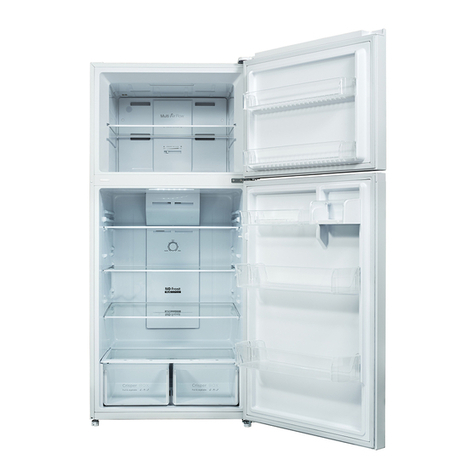
ChiQ
ChiQ CTM550W User manual
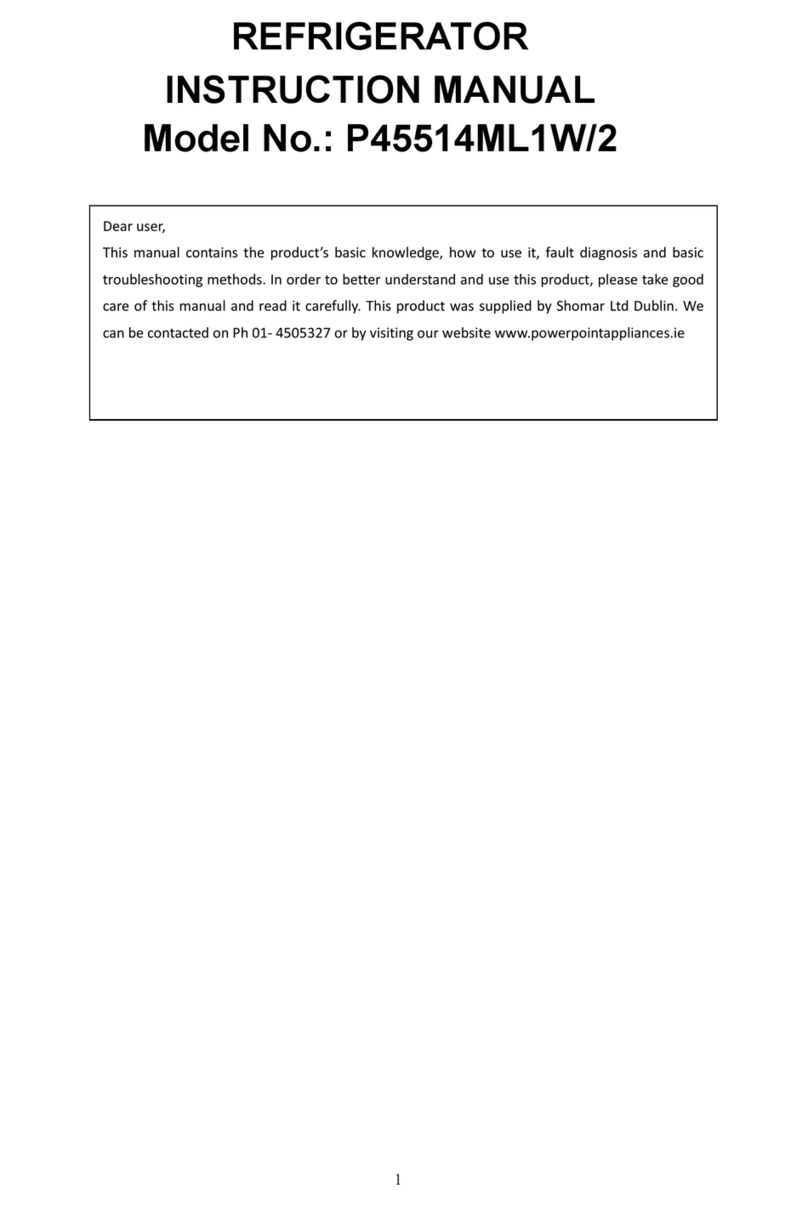
ChiQ
ChiQ P45514ML1W/2 User manual
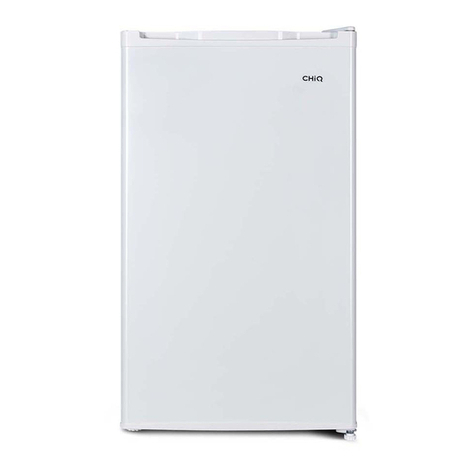
ChiQ
ChiQ CSR090DW User manual

ChiQ
ChiQ CQRQ15Y4G2RS User manual
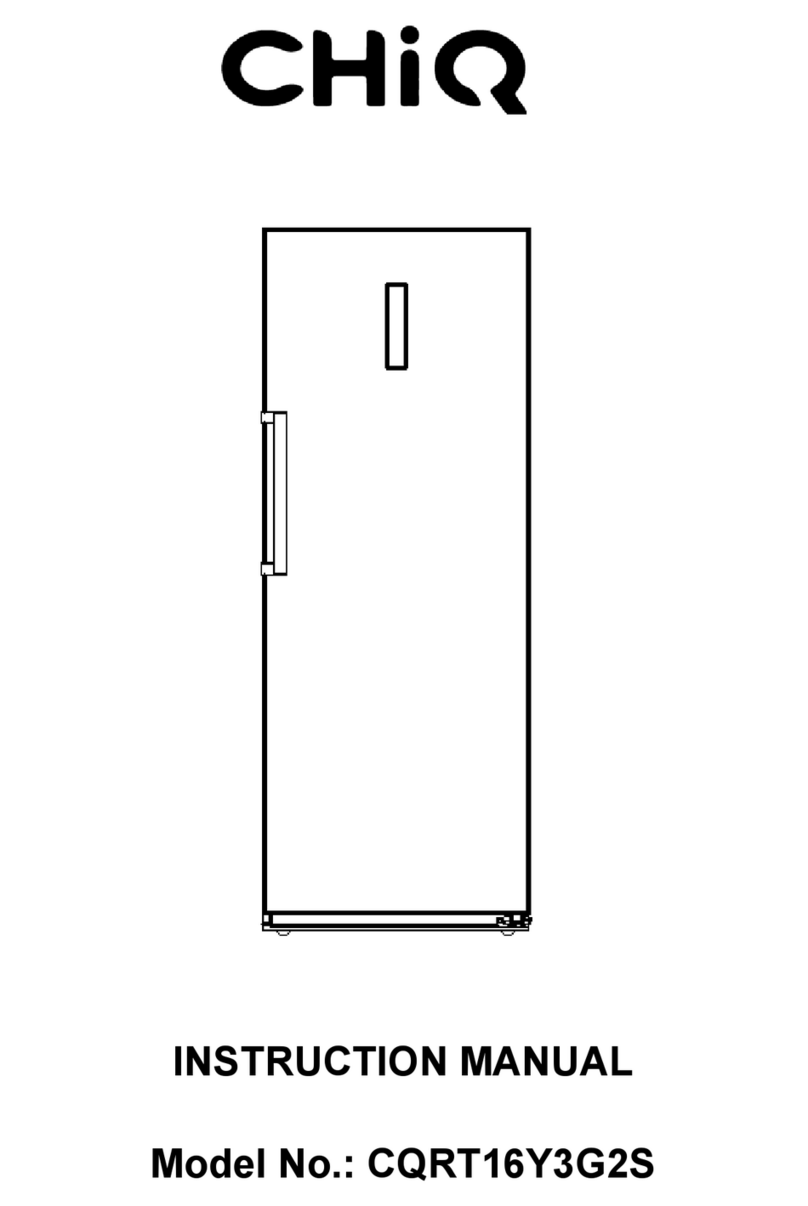
ChiQ
ChiQ CQRT16Y3G2S User manual
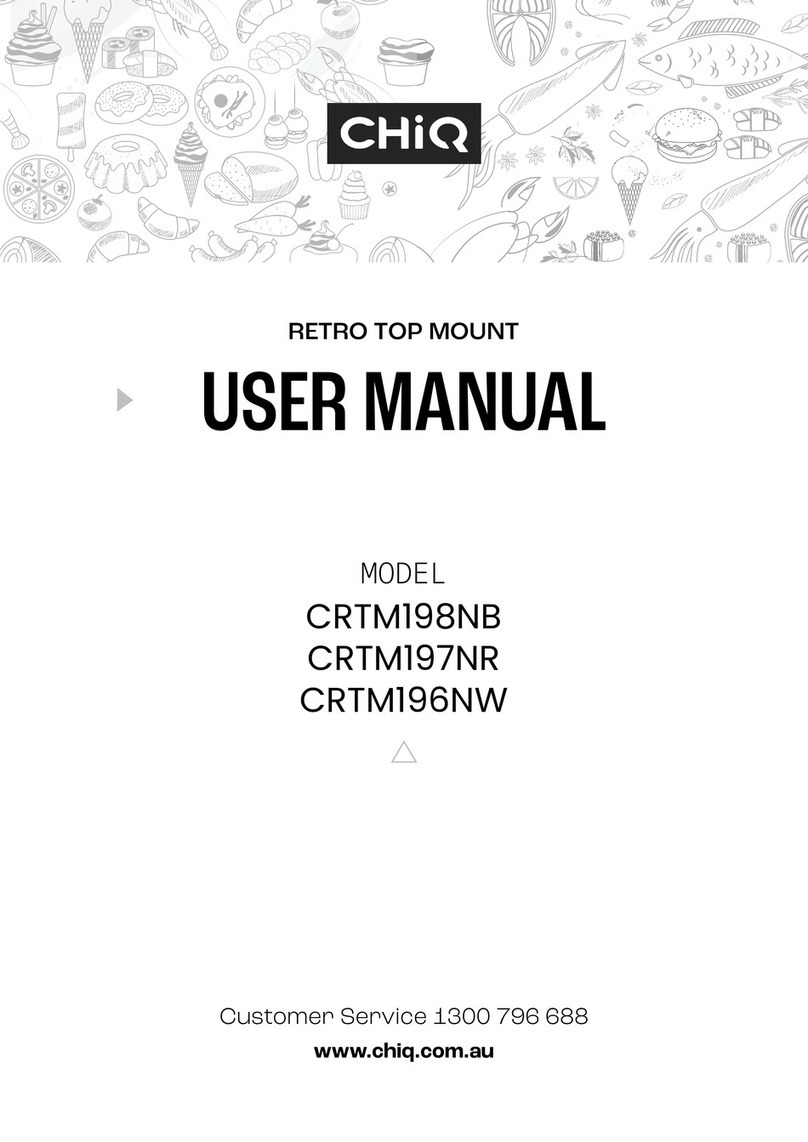
ChiQ
ChiQ CRTM197NR User manual
